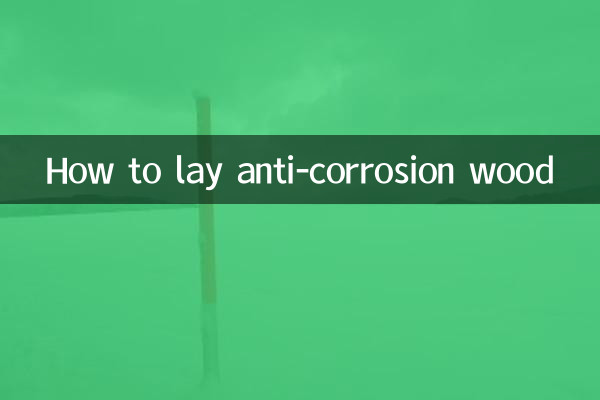How to lay anticorrosive wood: a complete guide from material selection to construction
In recent years, outdoor anti-corrosion wood has become a popular choice for home decoration due to its durability and beauty. Whether it's a patio floor, deck or garden path, antiseptic wood adds a natural feel to a space. This article will combine the hot topics and hot content on the Internet in the past 10 days to give you a detailed introduction to the steps, precautions and related data comparison of anti-corrosion wood laying.
1. Preparation work before laying anti-corrosion wood

Before laying anti-corrosion wood, the following preparations need to be done:
| step | Specific content |
|---|---|
| 1. Selection of materials | Choose wood that has been treated with anti-corrosion. Common materials include pine, fir, etc., and ensure that its anti-corrosion level meets the standards for outdoor use. |
| 2. Tool preparation | Electric drill, screws, level, saw, tape measure, rubber hammer, etc. |
| 3. Ground treatment | Make sure the ground is flat and, if necessary, lay down a layer of grass-proof sheeting or gravel to enhance drainage. |
2. Preservative wood laying steps
Laying anti-corrosion wood requires following scientific steps to ensure its stability and beauty:
| step | Operating Instructions |
|---|---|
| 1. Measurement and Planning | Measure the dimensions of the laying area and plan the direction and spacing of the wood. |
| 2. Fixed keel | First lay the keel as a support, the spacing is generally 40-60cm to ensure level. |
| 3. Lay anti-corrosion wood | Fix the anti-corrosion wood board to the keel, leaving a 5-10mm gap to facilitate drainage and wood expansion. |
| 4. Edge processing | Use a saw to trim the edges to ensure a neat appearance. |
| 5. Surface treatment | Apply wood oil or paint to enhance corrosion resistance and appearance. |
3. Precautions for laying anti-corrosion wood
During the laying process, the following points require special attention:
| Things to note | reason |
|---|---|
| 1. Leave a gap | Wood expands or contracts due to changes in humidity, leaving gaps to avoid deformation. |
| 2. Avoid direct contact with the ground | To prevent wood from absorbing moisture and rotting, it is recommended to use keels or pads. |
| 3. Regular maintenance | Check and reapply wood oil every year to extend service life. |
4. Comparison between anticorrosive wood and other materials
The comparison between anticorrosive wood and other common outdoor flooring materials is as follows:
| Material | advantage | shortcoming |
|---|---|---|
| antiseptic wood | Natural, beautiful, environmentally friendly, and highly customizable | Requires regular maintenance |
| Laminated wood flooring | Maintenance-free and durable | higher price |
| ceramic tile | Durable and easy to clean | Cooler and slippery in winter |
5. Frequently Asked Questions about Anticorrosive Wood Laying
The following are the popular issues that netizens have paid attention to in the past 10 days:
| question | answer |
|---|---|
| 1. Does anti-corrosion wood need to be painted? | It is recommended to brush wood oil or special paint to enhance anti-corrosion and aesthetics. |
| 2. How long can antiseptic wood be used? | Generally 10-15 years, depending on maintenance and environment. |
| 3. What should I do if there is deformation after laying? | Check to see if there are enough gaps and re-fix or replace the panels if necessary. |
Conclusion
Laying antiseptic wood is a technical job, but with scientific steps and precautions, you can easily create a beautiful and durable outdoor space. I hope this article can provide you with practical guidance to make your anti-corrosion wood project go smoothly!

check the details

check the details